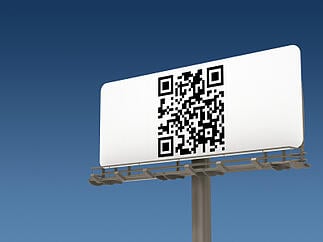I applaud companies and inbound marketers for taking a chance and testing new technologies such as QR codes (abbreviated from Quick Response Codes). After all, an important part of inbound marketing is testing and measuring. But the excitement of new technology can sometimes cause marketers to use tactics that leave me asking the question, "I wonder what they were thinking?" 
The intention of this article is not to publicly criticize a particular company, so I will leave company names out of my examples. But I do think it's important to share these examples as a way to illustrate how to incorrectly use QR Codes.
2 Examples of how NOT to Use QR Codes:
1. On a billboard hundreds of yards off the highway
I noticed this example on our drive back from a family vacation. We were coming around a curve in the highway when I noticed a billboard with a QR Code on it. (As marketers and designers, we're trained to see these things). The billboard was offset a great distance from the highway, and by the time I noticed it, I didn't even have enough time to read who the company was that was advertising on this billboard.
I immediately asked myself the following questions:
- Who was this intended for? The driver? The passenger? Kids in the back seat?
- How did they think anyone would have time to pull out their smart phones, launch their QR Scanner app, and scan this QR code before it was out of site?
- Would this QR Code even scan since we were constantly moving and at a terrible angle?
- If I could scan it, why would I want to? There was no call to action or incentive.
- Why did they choose a billboard with such poor visibility (near a curve which gives the viewer very little lead time)?
I'm sure their are good reasons for some of the points above, but that's a lot of red flags in a short period of time. It makes me think that this campaign had NO chance of success.
2. On the Jumbotron at a professional sporting event
This example could have had a chance for success, if done correctly. The biggest issue I had with this one was the duration in which this QR Code was displayed (roughly 3-5 seconds).
During a timeout of a professional sporting event, I glanced up at the Jumbotron and noticed a QR code (and just a QR Code - nothing else). I quickly reached for my iPhone to scan it, but by the time I got my phone in hand the message had changed. Convinced that the QR Code would be displayed again, I quickly launched my QR scanner and waited - only to be completely disappointed.
Some reasons why I think this example failed:
- Duration, as mentioned above
- Lack of a call to action and/or incentive - tell me why I should scan this
- The angle at which I was to scan the QR Code was too drastic
The last point above could be argued. I certainly didn't have courtside seats, nor was I in the "nose-bleed" section. They were slightly above average seats and I had to look nearly straight up to see the Jumbotron.
Maybe this QR code was intended for people in the sections that had a great vantage point of the Jumbotron - and if that was the case, then well done. But even if that was the case, the duration and incentive wouldn't have been enough for me to scan this.
Marketing Takeaway:
Be sure you think about the situation your audience will be in when they see your QR Code.
Will they have their phone handy? If so, do they have enough time to scan your QR Code? What incentive have you provided to encourage them to scan your QR Code?
What examples have you seen? Has your company tried using QR Codes in their marketing efforts? Do you think they failed or succeeded?
In my follow up blog post, I'll highlight a few examples of QR Codes done right. Stay tuned.




